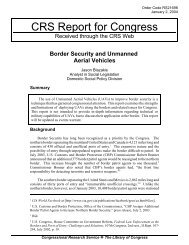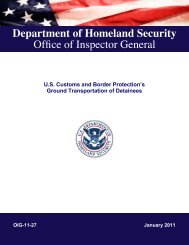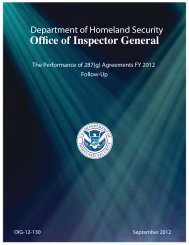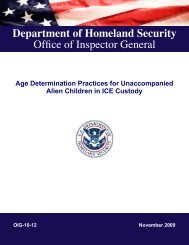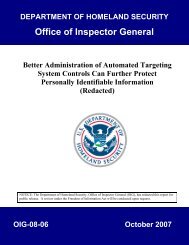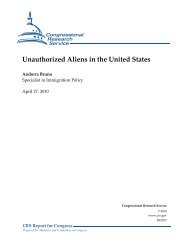U.S. Customs and Border Protection's Oversight of the Permit to ...
U.S. Customs and Border Protection's Oversight of the Permit to ...
U.S. Customs and Border Protection's Oversight of the Permit to ...
You also want an ePaper? Increase the reach of your titles
YUMPU automatically turns print PDFs into web optimized ePapers that Google loves.
Department <strong>of</strong> Homel<strong>and</strong> SecurityOffice <strong>of</strong> Inspec<strong>to</strong>r GeneralU.S. <strong>Cus<strong>to</strong>ms</strong> <strong>and</strong> <strong>Border</strong> Protection’s <strong>Oversight</strong> <strong>of</strong> <strong>the</strong> <strong>Permit</strong> <strong>to</strong> Transfer Process for Cargo Containers OIG-11-28 January 2011
BackgroundSection 809(g) <strong>of</strong> <strong>the</strong> Coast Guard <strong>and</strong> Maritime Transportation Act <strong>of</strong> 2004 (Public Law108-293) requires <strong>the</strong> Office <strong>of</strong> Inspec<strong>to</strong>r General <strong>to</strong> submit an annual report on itsevaluation <strong>of</strong> <strong>the</strong> U.S. Department <strong>of</strong> Homel<strong>and</strong> Security’s (DHS) current targetingsystem for international intermodal cargo containers. This is our sixth audit on selectedaspects <strong>of</strong> DHS’ targeting system. This year, we are focusing our efforts on determiningwhe<strong>the</strong>r CBP’s permit <strong>to</strong> transfer (PTT) process has effective controls in place <strong>to</strong> ensurethat <strong>the</strong> U.S. <strong>Cus<strong>to</strong>ms</strong> <strong>and</strong> <strong>Border</strong> Protection (CBP) secures <strong>and</strong> inspects all identifiedhigh-risk containers.CBP is responsible for targeting <strong>and</strong> conducting cargo examinations on cargo destined <strong>to</strong>enter United States commerce. In 2009, approximately 9 million containers arrived in <strong>the</strong>United States. To manage <strong>the</strong> potential security threats presented by this large volume <strong>of</strong>maritime cargo, CBP employs a multi-layered approach, including analyzing <strong>and</strong>reviewing shipment information <strong>and</strong> targeting <strong>and</strong> inspecting high-risk cargo. CBPrequires carriers <strong>to</strong> provide shipment information about <strong>the</strong> contents <strong>of</strong> <strong>the</strong>ir cargocontainers <strong>to</strong> determine <strong>the</strong> level <strong>of</strong> risk associated with <strong>the</strong> cargo. CBP uses <strong>the</strong>Au<strong>to</strong>mated Targeting System (ATS) <strong>to</strong> review this information, which includes <strong>the</strong>country <strong>of</strong> origin, type <strong>of</strong> merch<strong>and</strong>ise, <strong>and</strong> destination, <strong>to</strong> determine if <strong>the</strong> shipmentposes a high risk <strong>to</strong> <strong>the</strong> United States <strong>and</strong> should be examined prior <strong>to</strong> release. CBPallows importers up <strong>to</strong> 15 days after <strong>the</strong> arrival <strong>of</strong> <strong>the</strong>ir shipment <strong>to</strong> provide additionalshipping information.Cargo terminals have limited s<strong>to</strong>rage space <strong>and</strong> constantly receive new shipments.Therefore, title 19 Code <strong>of</strong> Federal Regulations (CFR) § 19.45 allows carriers <strong>to</strong> movecargo from <strong>the</strong> place <strong>of</strong> arrival using PTT once <strong>the</strong> application has been approved by <strong>the</strong>port direc<strong>to</strong>r. The CFR does not provide specific policy <strong>and</strong> procedures on how portsshould implement <strong>the</strong> PTT process. As a result, each port direc<strong>to</strong>r has established localpolicies <strong>and</strong> procedures based on port logistics <strong>and</strong> needs. In 2009, approximately176,000 containers were moved using <strong>the</strong> PTT process. Recent terrorist events such as<strong>the</strong> recent incidents concerning air cargo highlight <strong>the</strong> need for continued streng<strong>the</strong>ning<strong>of</strong> controls <strong>to</strong> protect <strong>the</strong> integrity <strong>of</strong> <strong>the</strong> nation’s cargo security efforts. As cargocontainers move through <strong>the</strong> supply chain, including <strong>the</strong> PTT process, each point <strong>of</strong>transfer increases <strong>the</strong> risk <strong>of</strong> vulnerabilities. The security <strong>of</strong> each transfer <strong>and</strong> <strong>the</strong>trustworthiness <strong>of</strong> each party involved within <strong>the</strong> PTT process are critical <strong>to</strong> <strong>the</strong> overallsecurity <strong>of</strong> <strong>the</strong> supply chain.Results <strong>of</strong> ReviewCBP does not have a centralized PTT process. Each <strong>of</strong> <strong>the</strong> six ports we visited processedPTTs differently using varying methods <strong>to</strong> mitigate risks including special queries inATS <strong>and</strong> <strong>the</strong> Au<strong>to</strong>mated Manifest System, as well as advanced targeting units who targetcargo needing an examination. Our audit tests did not identify significant deficiencies in<strong>the</strong> PTT processes at <strong>the</strong> ports we reviewed.1
We reviewed a r<strong>and</strong>om sample <strong>of</strong> 68 high <strong>and</strong> low risk PTTs for <strong>the</strong> first <strong>and</strong> secondquarter <strong>of</strong> FY 2010. Additionally <strong>to</strong> ensure high risk PTTs were properly inspected prior<strong>to</strong> release, we reviewed a sample <strong>of</strong> 295 high risk PTTs <strong>and</strong> a targeted sample <strong>of</strong> 60 o<strong>the</strong>rhigh risk cargo containers processed in July 2010.For each stage, we tested various key internal controls, such as port policies <strong>and</strong>procedures, determined whe<strong>the</strong>r PTT data requests <strong>and</strong> authorizations were properlyprocessed <strong>and</strong> verified that all high-risk cargo identified in our sample received <strong>the</strong>appropriate examination. We interviewed CPB Office <strong>of</strong> Field Operations personnel atCBP headquarters in Washing<strong>to</strong>n, D.C., <strong>and</strong> CBP supervisors <strong>and</strong> <strong>of</strong>ficers at <strong>the</strong> ports wevisited. We also interviewed non-CBP supervisors <strong>and</strong> employees working in varioustypes <strong>of</strong> warehouses, including container examination stations, container <strong>and</strong> foreigntrade zones, <strong>and</strong> cus<strong>to</strong>ms bonded warehouses.This report does not contain any recommendations.Management Comments <strong>and</strong> OIG AnalysisWe obtained written comments on a draft <strong>of</strong> <strong>the</strong> report from <strong>the</strong> U.S. <strong>Cus<strong>to</strong>ms</strong> <strong>and</strong> <strong>Border</strong>Protection’s Office <strong>of</strong> Internal Affairs Assistant Commissioner, James Tomsheck,responsible for taking corrective action. CBP generally concurs with <strong>the</strong> content <strong>of</strong> <strong>the</strong>report <strong>and</strong> <strong>of</strong>fered no technical or general comments. We have included a copy <strong>of</strong> <strong>the</strong>comments in Appendix B.2
Appendix APurpose, Scope, <strong>and</strong> MethodologyThe objective <strong>of</strong> this audit was <strong>to</strong> determine whe<strong>the</strong>r CBP’s permit <strong>to</strong> transfer(PTT) process has effective controls in place <strong>to</strong> ensure that CBP secures <strong>and</strong>inspects all identified high-risk containers. We selected a sample <strong>of</strong> ports thatprocessed <strong>the</strong> highest volume <strong>of</strong> cargo containers <strong>and</strong> selected additional ports asa representative sample <strong>of</strong> <strong>the</strong> differing sec<strong>to</strong>rs in CBP. Those ports included LosAngeles <strong>and</strong> Long Beach, California, Newark, New Jersey <strong>and</strong> New York, NewYork, Norfolk, Virginia, Hous<strong>to</strong>n, Texas <strong>and</strong> Miami <strong>and</strong> Port Everglades, Florida.We reviewed a r<strong>and</strong>om sample <strong>of</strong> 68 high <strong>and</strong> low risk PTTs for <strong>the</strong> first <strong>and</strong>second quarters <strong>of</strong> FY 2010. Additionally <strong>to</strong> ensure high risk PTTs were properlyinspected prior <strong>to</strong> release, we reviewed a stratified sample <strong>of</strong> 295 high risk PTTs<strong>and</strong> a targeted sample <strong>of</strong> 60 o<strong>the</strong>r high risk cargo containers processed in July2010. We assessed adherence with Title 19 Code <strong>of</strong> Federal Regulations (CFR)§ 19.45 <strong>and</strong> CBP’s port-specific policies <strong>and</strong> procedures in <strong>the</strong> key stages <strong>of</strong> <strong>the</strong>PTT process for processing high-risk shipments.We conducted this performance audit between June <strong>and</strong> December 2010 pursuant<strong>to</strong> <strong>the</strong> Inspec<strong>to</strong>r General Act <strong>of</strong> 1978, as amended, <strong>and</strong> according <strong>to</strong> generallyaccepted government auditing st<strong>and</strong>ards. Those st<strong>and</strong>ards require that we plan<strong>and</strong> perform <strong>the</strong> audit <strong>to</strong> obtain sufficient, appropriate evidence <strong>to</strong> provide areasonable basis for our findings <strong>and</strong> conclusions based upon our audit objectives.We believe that <strong>the</strong> evidence obtained provides a reasonable basis for our findings<strong>and</strong> conclusions based upon our audit objectives.We appreciate <strong>the</strong> cooperation by CBP management <strong>and</strong> staff in providing <strong>the</strong>information <strong>and</strong> access necessary <strong>to</strong> accomplish this review.3
Appendix BManagements Comments <strong>to</strong> <strong>the</strong> Draft Letter Report~•J ,CO "'''''*"'"" ,'.......,"_,,", OC'0'" ~wU.S.Cwtml <strong>and</strong>Borda Protttti
Appendix CMajor Contribu<strong>to</strong>rs <strong>to</strong> This ReportPaul Wood, Direc<strong>to</strong>r, Trade Operations <strong>and</strong> SecurityShelley Howes, Audit ManagerJeffrey Wilson, Team LeadRobert Edwards, Senior Audi<strong>to</strong>rElizabeth Garcia, Senior Audi<strong>to</strong>rAndre’ Marseille, Program AnalystJeff Mun, Program AnalystDavid Kinard, Referencer5
Appendix DReport DistributionDepartment <strong>of</strong> Homel<strong>and</strong> SecuritySecretaryDeputy SecretaryChief <strong>of</strong> StaffDeputy Chief <strong>of</strong> StaffGeneral CounselExecutive SecretariatDirec<strong>to</strong>r, GAO/OIG Liaison OfficeAssistant Secretary for Office <strong>of</strong> PolicyAssistant Secretary for Office <strong>of</strong> Public AffairsAssistant Secretary for Office <strong>of</strong> Legislative AffairsUnited States <strong>Cus<strong>to</strong>ms</strong> <strong>and</strong> <strong>Border</strong> ProtectionAssistant Commissioner, CBPDirec<strong>to</strong>r, Office <strong>of</strong> Field OperationsCBP Audit LiaisonOffice <strong>of</strong> Management <strong>and</strong> BudgetChief, Homel<strong>and</strong> Security BranchDHS OIG Budget ExaminerCongressCongressional <strong>Oversight</strong> <strong>and</strong> Appropriations Committees, asappropriate6
ADDITIONAL INFORMATION AND COPIESTo obtain additional copies <strong>of</strong> this report, please call <strong>the</strong> Office <strong>of</strong> Inspec<strong>to</strong>r General (OIG) at (202) 254-4100,fax your request <strong>to</strong> (202) 254-4305, or visit <strong>the</strong> OIG web site at www.dhs.gov/oig.OIG HOTLINETo report alleged fraud, waste, abuse or mismanagement, or any o<strong>the</strong>r kind <strong>of</strong> criminal or noncriminalmisconduct relative <strong>to</strong> department programs or operations:• Call our Hotline at 1-800-323-8603;• Fax <strong>the</strong> complaint directly <strong>to</strong> us at (202) 254-4292;• Email us at DHSOIGHOTLINE@dhs.gov; or• Write <strong>to</strong> us at:DHS Office <strong>of</strong> Inspec<strong>to</strong>r General/MAIL STOP 2600,Attention: Office <strong>of</strong> Investigations - Hotline,245 Murray Drive, SW, Building 410,Washing<strong>to</strong>n, DC 20528.The OIG seeks <strong>to</strong> protect <strong>the</strong> identity <strong>of</strong> each writer <strong>and</strong> caller.



